Whistling Through the Graveyard
Chapter 9 - Death Outside A Cemetery
Whistling Through The Graveyard Chapter 10
Whistling Past The Runway Chapter 1
Prince Galitzine and the German Daedalus
The story that follows has nothing to do with genealogy. It is history, specifically aviation history. I will have more stories like this and those are being split off into a different set of articles, "Whistling Past the Runway". If there is an article that overlaps between the two series I will link it into both like this one is.
I woke from a dream.
There was something earlier, which evaporated from my awareness as I struggled towards consciousness. What I clearly remembered from the dream was something I had read about a year or two ago, a WWII era high altitude German reconnaissance plane that had been powered by (of all things) turbocharged diesel engines. It sounds completely insane, but there was such a plane. I couldn't remember the manufacturer off the top of my head (Dornier, perhaps?) but I had found a story about it on the internet and I said to myself, "I'm going to have to look that up again.".
I went to my computer and said to my wife Michelle, "I just had the weirdest dream" but I didn't offer any details. Michelle didn't comment about it, since I make this kind of comment to her regularly. Why I would dream about a WWII reconnaissance plane is beyond me, but I dream about all kinds of strange things.
I fiddled on the computer for a while then went out to make a grocery store run and bring some dinner home. Those errands run, Michelle and I ate dinner and I did some more stuff on the computer, then went into the living room about 9 pm. Michelle had found something free to watch on one of the streaming channels, it wasn't necessarily a movie she was going to get much out of but she thought I'd enjoy it. The title as displayed on the streaming channel was 303 Squadron: Battle of Britain. I looked it up later and found it was released theatrically under a different but similar title.
By the way, my wife does not normally find war movies for me to watch. I have plenty in my own collection. But it was a thoughtful thing for her to do and since I had never heard of that movie it was worth a look.
Michelle and I watched the movie. It was based on a true story from WWII, about a group of Polish and other expatriate pilots who made their way to Britain in the early days of the war and were placed into a separate squadron in the RAF called (big surprise here!) 303 Squadron.
I couldn't tell you whether the movie was any good or not, but I found it entertaining. There was something a bit jarring, though. The movie was a Polish production (again not too surprising) and since it was set in Britain most of it was in English but the pilots spoke a lot of Polish to one another, and there were no subtitles in the version of the movie on the streaming channel. In addition to the Polish (which was also spoken in flashbacks to prewar Poland and scenes that took place in September 1939 during the German and Soviet invasions), there were quite a few scenes with German dialog, a bit of French, a smidgen of Russian, and I think perhaps a few lines of Italian.
I could follow a little bit of the German and the French (not much) but I was completely lost with the other dialog. It might be interesting to find a copy of the movie with subtitles and watch it again to see if it was any easier to follow.
303 Squadron was based at RAF Northolt, a base I did not remember from my reading but apparently one that saw quite a bit of activity during the war, and is still an active RAF base today. It was founded as a Royal Flying Corp base in 1915, so it predates the establishment of the RAF by three years. It is the oldest RAF base and has the longest history of continuous use of any RAF airfield. I must have run across it before but just not remembered the name.
Once the movie was over I went back to my computer and looked up a couple of things about it. It came out in 2018, and oddly enough there was a completely separate movie about the same subject which came out at the same time, Hurricane (also known as Hurricane: 303 Squadron and 303: Bitwa o Anglie in Poland and Mission of Honor in the United States). Apparently the near simultaneous release of the two films about the same subject has led to much confusion about which film was which. The movie we saw, although titled 303 Squadron: Battle of Britain on the streaming channel, was released as 303 Squadron: The True Story to English language audiences and as Dywizjon 303. Historia prawdziwa in Polish (the name of the squadron rendered in Polish was Dywizjon 303, which was a shortened version of the full name, Dywizjon Mysliwski "Warszawski im. Tadeusza Kosciuszki"). A loose translation of that is "Fighter Division Warsaw named Tadeusz Kosciusko" (the famous Polish expatriate soldier who joined the Continental Army during the American Revolutionary War).
So that was all very interesting. I have done a great deal of research on expatriate foreign pilots in the RAF so whether the movie was any good or not I learned something from it.
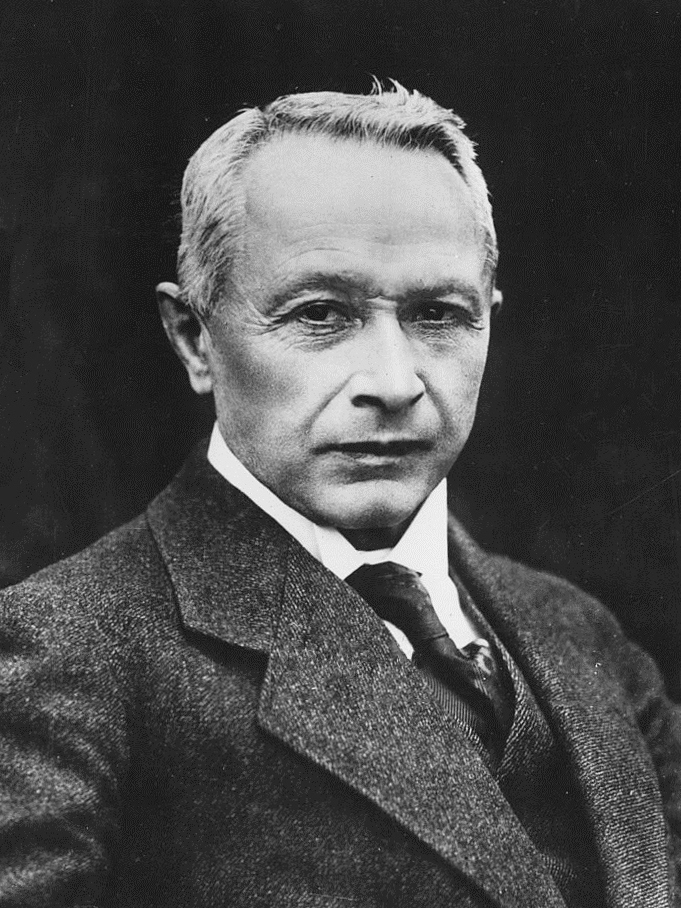 Hugo Junkers circa 1920
Hugo Junkers circa 1920
With that out of the way, I decided to figure out which German reconnaissance plane had been in my dream. I found it fairly quickly. It was the Junkers Ju 86 P and R marks, both of which were optimized for high altitude flight. I got a bit lost in the details of it as some fairly wild things were done to the engines and the planes for them to work at high altitudes.
Hugo Junkers, the founder of the Junkers Aircraft Company, is the Daedalus of our tale. An engineering genius, he developed some of the most innovative civil aviation designs from before WWI to the early 1930s. In 1976, 41 years after his death, Junkers was inducted into the International Air & Space Hall of Fame.
One of his pet projects was making diesel engines work in aircraft. This was considered impossible or at the very least impractical by most aircraft engineers of the period. Diesel engines, although rugged, reliable and efficient, didn't have the same horsepower to weight ratio as gasoline engines and were considered too heavy to use by most designers.
The first successful flight of a diesel powered airplane took place in 1928 when a Packard powered Stinson SM1-DX first flew. The first Junkers designed diesel aviation engine (through the engine subsidiary of Junkers, Jumo) was released as the Jumo 205 in 1932. The Wikipedia article on the Jumo 205 states that for over 50 years the Jumo 205 series were considered the only successful diesel aviation engines.
For those of you who find these things interesting, a fairly technical explanation of the Jumo engine follows. It was an opposed two stroke engine with 12 pistons sharing six cylinders. This was a quite unusual configuration which required two crankshafts. The intake ports were at one end of the engine and the exhaust ports at the other, and the lower crankshaft ran 11 degrees behind the upper crankshaft. This allowed the engine to run almost as cleanly as a four stroke engine but with much less complexity.
Some of the problems with this design were avoided by using the upper crankshaft as the main power source and using the lower crankshaft to run accessories such as the fuel pumps, fuel injectors, and scavenging (replacing exhaust gas with a fresh fuel/air mixture to burn in the next cycle).
One of the beauties of this design was that since the temperature of the diesel exhaust gases was much lower than the corresponding exhaust from gasoline powered engines it was much easier to add a turbocharger for higher altitude operation. A relatively inefficient mechanical blower ran at low load but at higher loads the turbocharger kicked in and effectively became a supercharger, running solely off the exhaust gases being expelled from the engine.
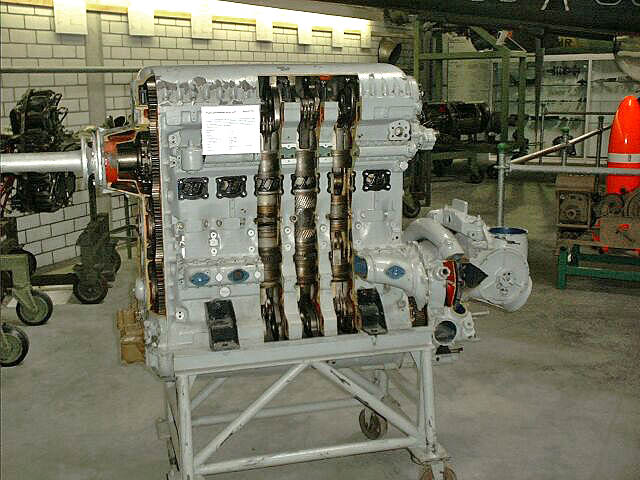 Jumo 205 engine with partial cutaway
Jumo 205 engine with partial cutaway
I don't know what of this, if any, was personally designed by Hugo Junkers. But his dedication to the project of a diesel powered airplane and bringing it to fruition makes it his baby, no matter how many other hands touched it during the design phase.
I already knew a couple of things about Hugo Junkers before I researched this plane. One, that he died on his birthday (I had thought 75th but Wikipedia says 76th, so it's probably right). I also knew that he had founded the Junkers Aircraft Company. His first company was founded in 1895, and I don't know if it later morphed into the aircraft company or if he founded a separate company before WWI to manufacture airplanes. It seems from the timeline that his work on airplanes began in earnest between 1905 and 1910.
I also knew that Junkers had some disagreements with the Nazis after they came to power and they effectively took his company away from him and placed him under house arrest for the last year or so of his life. There is speculation that his refusal to put the resources of his company at the disposal of the Nazis was due to his socialist beliefs (which definitely did not play well with the fascism the Nazis espoused) and his pacifist ideals..
One should contrast what Junkers did with the actions of other countrymen of his during the war such as Wernher von Braun, another engineering genius but one who saw no choice but to work for the German missile program.
Beyond losing his company, I suspect that the stress of what he went through probably contributed to Hugo's death in 1935. Although he was certainly not a young man when he died, I have to wonder how long he might have lived had he not gone through the ordeal of losing his companies and being placed under house arrest, in addition to knowing that everything he had built up was going to be put to the service of the Nazis.
One of the first designs the government requested after it took over the company was a dual use civilian/military plane that could serve as an airliner or a bomber. This became the Junkers Ju 86. The bomber version first saw combat during the Spanish Civil War, where the diesel engines proved unsuitable for the rigors of combat flight. Most of the planes that were left ended up being transferred to bomber training schools or being converted into transports.
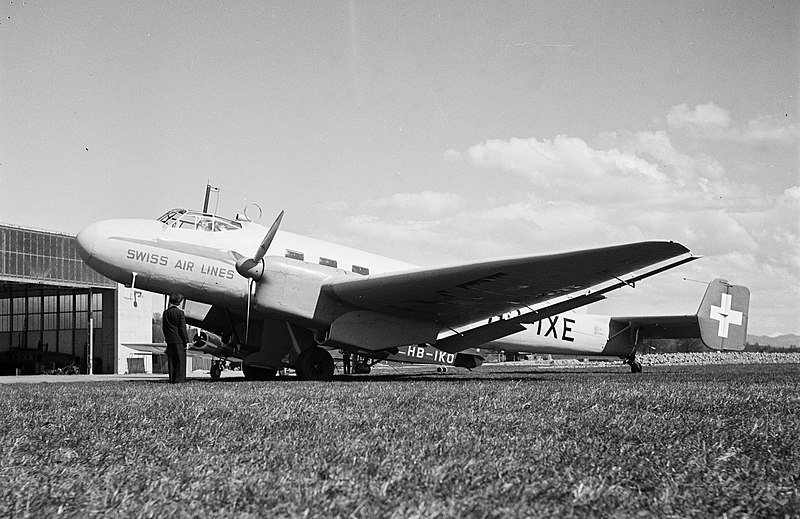 Civil SwissAir model
Civil SwissAir model
Virtual Sidebar: According to Wikipedia, the chief designer for the Ju 86 was Ernst Zindel. There is an article on him on German Wikipedia but it's quite short, just longer than a stub. I google translated the article, it looks like Zindel worked on quite a lot of the Junkers designs from the 1920s into the 1940s.
However, Junkers was not done with the Ju 86 design. In 1940 it developed the Ju 86P. This version of the plane had a longer wingspan, a pressurized cabin (unheard of at the time), Jumo 207 engines (an upgrade of the 205), and only a two man crew. However, the propellers were still 3 bladed ones. The P version had two subversions, one was a high altitude bomber and the other a dual bomber/reconnaissance plane, where the enhancements made enabled it to fly at altitudes of 39,000 feet and above. The significance of that number was that it was higher than the service ceiling of every production fighter in the world at that time.
By way of comparison, most commercial jet airliners today cruise at an altitude of 30,000 to 40,000 feet, and that's with much more advanced technology than Junkers had in 1940.
The Luftwaffe was happy enough with the performance of this model that they requested 40 of the earlier version planes be converted into the P version.
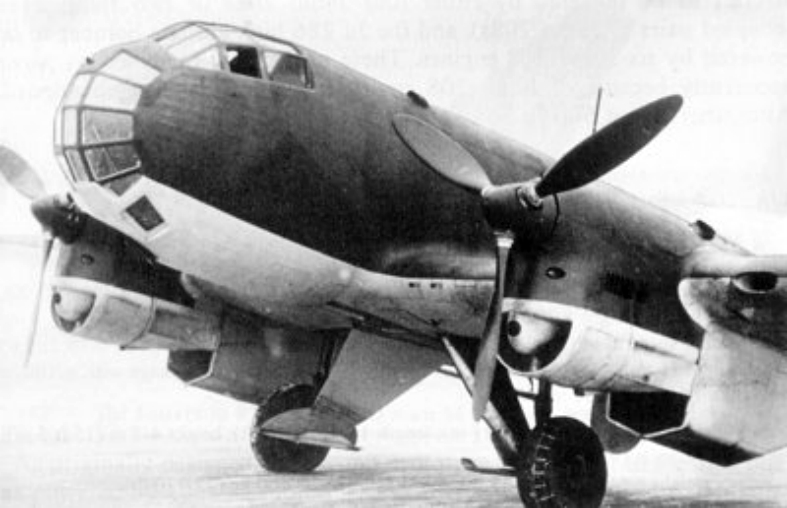 Ju 86P high altitude version (the R version probably looked almost identical with the exception of having 4 bladed props rather than the 3 bladed ones shown here)
Ju 86P high altitude version (the R version probably looked almost identical with the exception of having 4 bladed props rather than the 3 bladed ones shown here)
Some versions of the Ju 86 were equipped with radial gasoline engines rather than the diesels, these can visually be identified by the round engine nacelles as opposed to the vertical nacelles of the inline diesel engines. As far as I know none of the radial engine versions had particularly noteworthy performance at higher altitudes and most were used for transport aircraft.
The Ju 86P was used for reconnaissance over Great Britain, North Africa, and the Soviet Union. I don't know that any of the ones operating on the Eastern Front were lost to enemy action, but the RAF became very annoyed at the Luftwaffe flying over them with impunity and undertook a program to modify some Spitfire fighters in order to allow for a possible interception of the Junkers plane.
Virtual sidebar: The Ju 86 is not as well known as some other Junkers designs. The infamous Ju 87 Stuka dive bomber is a staple of WWII movies. Over 15,000 of the stalwart Ju 88 bomber were manufactured and it was in service for the entire war. Followups to the Ju 88 were the Ju 188 and 388, although comparatively few of those planes were made. Engines made by the Junkers Jumo subsidiary included the Jumo 004, the world's first operational turbojet engine, which powered the Me 262 jet fighter and the Ar 234 bomber.
The Ju 86 bomber raids over England were mostly nuisance raids, but on 28 August 1942 one dropped a bomb in central Bristol which killed 48 people and wounded 56 more. This almost certainly gave the British project to intercept the Junkers reconnaissance planes a higher priority.
The articles I am reading differ a bit on what the last versions of the Ju 86 that saw service were. Wikipedia states only the P versions entered service and the R versions were prototypes only. The article I have found on the plane on the History Net website says that the intercept which I describe below was of a Ju 86-R2, which had additional high altitude enhancements from the P marks such as 4 bladed propellers and a service ceiling of 47,000 feet. The History Net article seems very specific on this point so it appears to be a credible source.
In England in 1942, only the Spitfire Mark IX had enough performance to conceivably intercept one of the Ju 86s. The Mark IX had a service ceiling of 42,000 feet but the British already knew that the reconnaissance planes the Germans were overflying them with could go higher. So a program was undertaken to customize some of the newest Spitfires to enable them to intercept the Junkers planes.
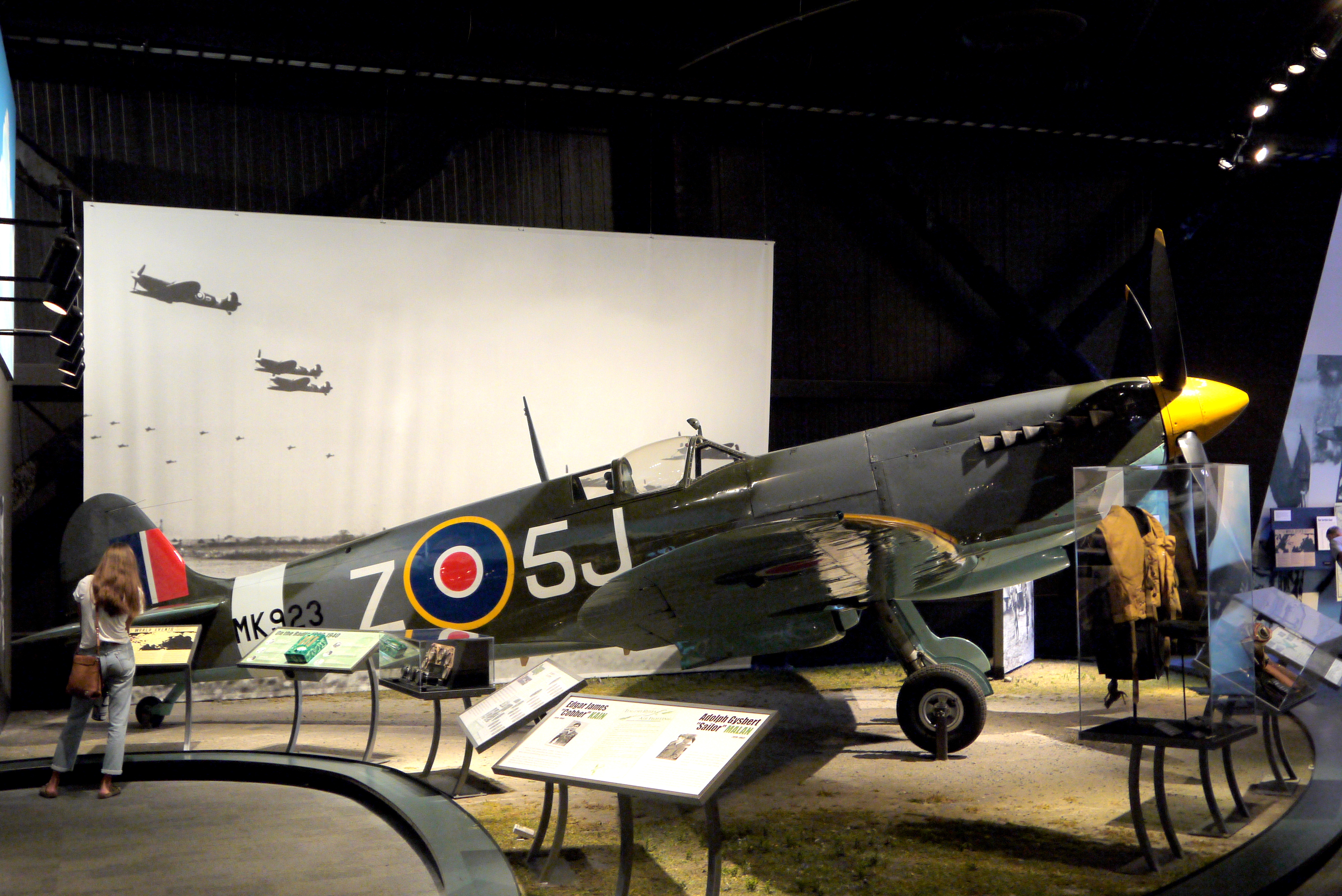 Spitfire Mk IX (Seattle Museum of Flight, this plane once owned by actor Cliff Robertson)
Spitfire Mk IX (Seattle Museum of Flight, this plane once owned by actor Cliff Robertson)
Metal propellers were replaced with wooden ones to save weight. All armor was removed to save more weight. The four machine guns were removed, leaving only the 20 mm cannon as offensive armament. In addition, the planes were painted with a special lightweight paint to save additional weight.
One of the pilots selected to fly the modified Spitfires was Pilot Officer Emanuel Galitzine. He was born in 1918 in revolutionary Russia, but taken from the country as an infant to France and then to England. The Galitzines were a branch of the family whose name is more commonly rendered as Golitsyn; they are Russian nobility going back to the 15th century. After the Bolsheviks took over Russia, dozens if not hundreds of the Golitysns who had remained behind were imprisoned or executed.
So Emanuel Galitzine likely had no love lost for the Soviet Union, but he was no friend of Nazi Germany either. He was a sixth cousin of King George VI, the reigning monarch of Britain during WWII. The title of "Prince" bestowed upon him would be from his descent from Tsar Paul I, who was his great-grandfather.
Galitzine volunteered to serve as a pilot with the Finnish Air Force during the Winter War with the Soviet Union of 1939-1940, but by the time he showed up in Finland a cease fire had taken place. Any doubts about what to do next were removed when he found out his mother had been killed by a German bombing raid during the London Blitz. Through a tortuous journey from Finland to the US to Canada and then back to England, Galitzine finally returned and joined the RAF. He was initially posted to 504 Squadron in Northern Ireland but in 1942, the following year, he joined the fighter unit training to shoot down the high altitude German reconnaissance planes.
Galitzine took one of the modified Spitfires up on a test flight and achieved a height of 43,000 feet with unparalleled views of the English countryside and across the Channel to occupied France.
On 12 September 1942 the RAF early warning radar detected a plane climbing to a very high level over the French coast headed towards England. This was clearly one of the Junkers planes and Galitzine's unit was alerted. He climbed into one of the Spitfires and took off to intercept the German plane.
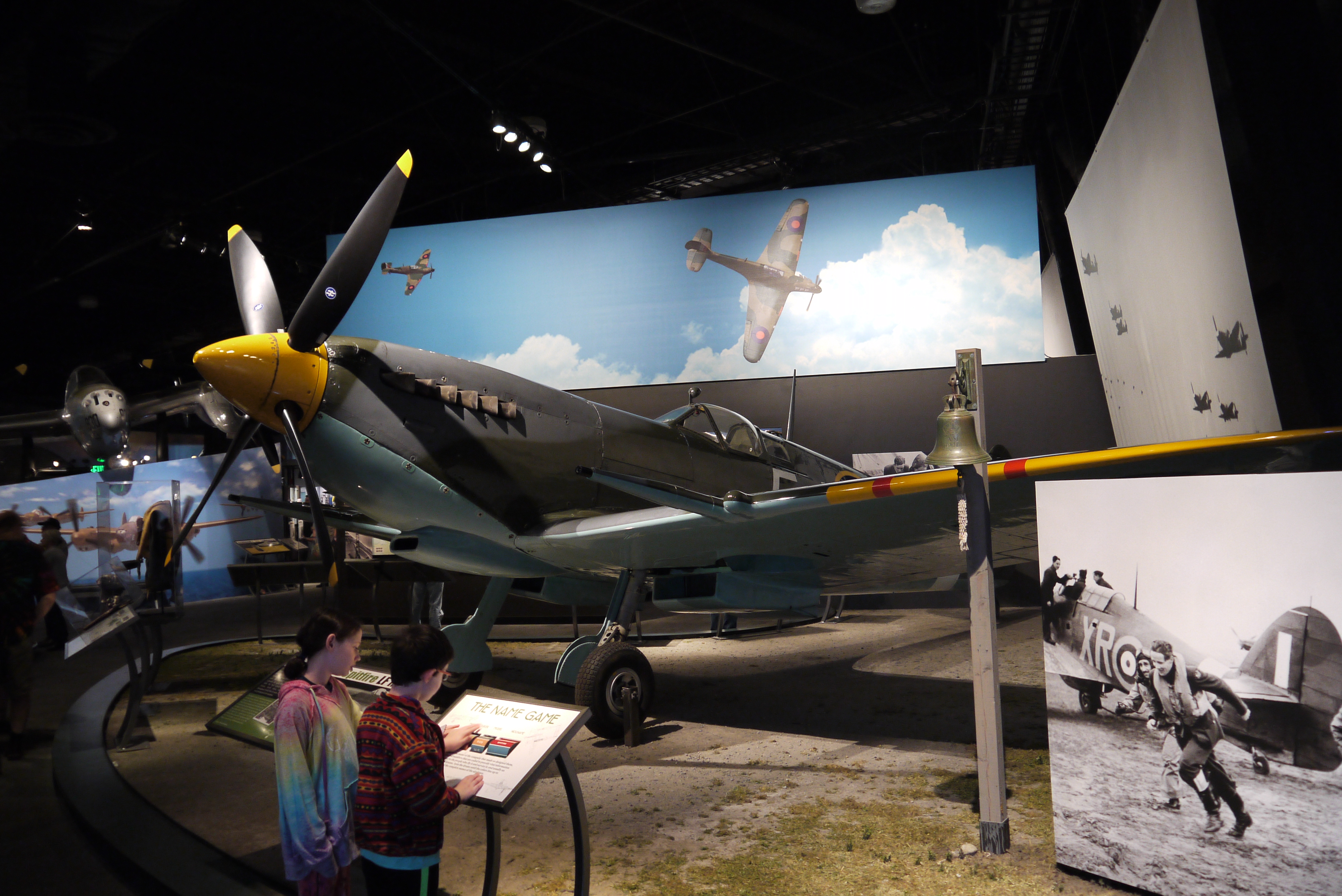 Spitfire Mk IX (Seattle Museum of Flight, same plane as photo above)
Spitfire Mk IX (Seattle Museum of Flight, same plane as photo above)
This is where, to me, the story got very interesting. Galitzine took off from RAF Northolt, Wait, where have we seen that name before? Oh yeah, the airfield that the Polish 303 Squadron was flying out of in the movie that I talked about earlier. But I saw that movie AFTER I dreamt about the Junkers Ju 86.
Holy shit, batman! We just had another extremely weird moment here!
I'm going to leave aside the philosophical implications of what I just described and return to the story at hand. Galitzine was climbing like the devil in the modified Spitfire headed south towards Portsmouth when he encountered the Junkers at least 40,000 feet above the English countryside. The German pilot, Sergeant Horst Gotz, spotted Galitzine's Spitfire approaching him and was shocked to see the British plane continuing to ascend towards the altitude of the Ju 86, which had never happened before. Gotz jettisoned his meager bomb load (a single 250 kilogram bomb) and hit the button to inject nitrous oxide into the engines to give them more power.
Galitzine had his own trump card to play, dropping his external 30 gallon fuel tank so he could follow the Junkers higher. He made a firing run on the bomber but shortly after that his left cannon jammed. The right cannon continued to fire but the asymmetric recoil from having only a single cannon firing kept sending him veering into the contrail of the Junkers, which frosted over his windscreen causing him to lose visibility. Galitzine would then have to wait until his canopy defrosted before he could renew the attack. This happened three times before Galitzine had to break off his attack because he was running low on fuel.
Galitzine might not have achieved the highest aerial shootdown in history, but the combat did set one record. With altitudes reaching 44,000 feet, the encounter between the two aircraft became the highest documented air to air combat of WWII.
When the Junkers landed at Caen the crew found at least one cannon hole in the left wing from a round Galitzine had fired. After the paperwork was filed on the mission, the Luftwaffe ceased sending the Ju 86s across the English channel during daylight, knowing now that the RAF had the capability to intercept them. I don't know if any nighttime missions were flown after that, they could have continued the nuisance bombing raids but the photo technology of the time would have ruled out nighttime reconnaisance flights.
Around thirty years later Gotz and Galitzine finally met one another in person and recalled their impressions of the battle from opposite viewpoints. That must have been quite an interesting conversation.
The Hun scourge over southern England was done for now, but there was another theater where the Ju 86s were having much more than a nuisance effect on the Allied war effort -- North Africa.
In North Africa in the summer of 1942, the Junkers planes were providing vital intelligence to the Afrika Korps as to what the British Army was doing behind the battle lines. Flying Ju 86-Ps out of Crete, the Germans flew with impunity over Egypt to surveil what the British were doing. (I did an oopsy there, I remembered to spell Afrika the German way but spelled Corps with the English spelling before I fixed it, which probably would have gotten me killed if I was a character in the movie "Inglorious Basterds")
There weren't any available Spitfire Mark IXs to send to North Africa to intercept the Junkers planes. However, as it turned out, it wasn't necessary to use the Mark IXs.
The boundary between the lower levels of the atmosphere (the troposphere) and the higher levels (the stratosphere) is called the tropopause. The height of the tropopause varies with latitude, ranging from 20,000 feet at the poles to 60,000 feet at the equator. In the latitudes of southern England, the tropopause is at an elevation somewhere around 35,000 feet. This is where the performance of piston engine aircraft experiences a sharp decline. In North Africa, the tropopause is at a much higher altitude, so piston engine aircraft can fly much higher.
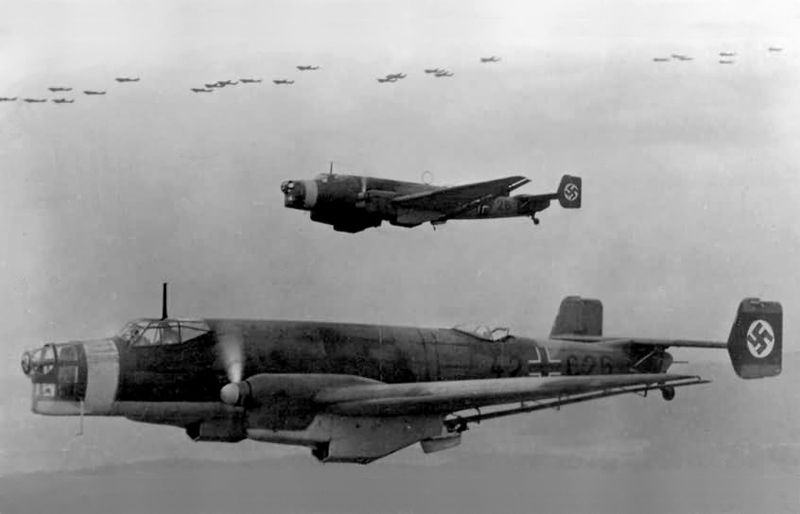 Ju 86 bomber formation in flight
Ju 86 bomber formation in flight
At the Aboukir air base in Egypt, the RAF modified some Spitfire Mark Vs by removing their armor (or armour, as the Brits say) and four standard machine guns (replacing the two cannon with two .50 caliber machine guns). These were similar to the Mark IX modifications in Britain. In addition, the three bladed props were replaced with four bladed props, engine compression was increased to provide more power, and the wings were extended by modifying them with the wingtips used on the Spitfire Mark VI.
On 24 August, Flying Officer George Reynolds used one of the modified Spitfires to intercept a Ju 86 near Cairo at 37,000 feet. The Junkers ascended to 42,000 feet and Reynolds followed and opened fire without doing any discernible damage. It's possible Reynolds was so used to the cannon armament of the standard Spitfires that he wasn't close enough to do any damage with only the two machine guns of the modified Spitfire.
More modifications were made to the Spitfires. It was decided to employ the planes in teams of two aircraft. One had the radio and antenna mast removed, a lighter battery was installed, and the planes were fueled with 30 less gallons, also reducing their weight. These were the "Striker" planes. The unmodified "Marker" planes with functioning radios would fly below the modified Spits but within visual range of the latter to help vector them onto the target.
I don't know if what is described in the paragraph above was already in progress by the time of Reynolds' flight on the 24th, or if it actually happened immediately afterwards. In any event these modifications and system were in place by 6 September 1942, if not earlier.
On 29 August 1942 Pilot Officer George Eric "Eric" Clifford Genders intercepted a Ju 86 and fired a short burst of machine gun fire at it, damaging the German plane before his guns jammed. The damage must have been significant, Genders was only able to claim a damaged plane but German records indicate the Junkers didn't make it back to Crete, it ditched in the Mediterranean but the crew were rescued.
The climax of this story happened a week later, on 6 September, when an RAF team intercepted another Junkers. The chase took the three planes out over the Mediterranean Sea, where Genders' machine gun fire damaged the German plane enough that it had to descend to lower altitude. There the "Marker" plane flown by Pilot Officer Arthur Gold pounded on it some more. The Ju 86 made a run towards Libya and the comparative safety of German lines, which it managed to make before crash landing in the desert.
Genders, unfortunately, had expended all his fuel in the chase and ditched off the Egyptian coast, where he was faced with a 21 hour swim before making landfall.
Since there had only been a few of the Ju 86Ps based in Crete and now all but one of them were gone (presumably the one that crash landed in the Libyan desert was written off), the Germans made the same decision in North Africa they had made over England and ceased the Ju 86 flights.
I haven't found the names of any of the crew members of the German planes downed in Africa and the Med. Hopefully some of that information will come to light in the future, although I'm not holding my breath. For now, suffice it to say that these stand-ins for Icarus did lose their wings and come to earth (or sea, which is entirely apropos considering both the legendary Icarus and the crew of the Junkers that ditched ended up in the Mediterranean).
I'm still trying to find out more information about Genders, Gold and Reynolds. I do know that Genders became a test pilot after the war and was killed flying the prototype of a De Havilland D.H.108 in 1950.
Emanuel Galitzine ended up working in the aviation industry after the war, first flying commercial aircraft and then apparently becoming a salesman and then founding his own aviation sales company. There is an amusing story about how he was kept waiting by the King of Morocco and he managed to speed things up by telling them he was a cousin of the Queen of England. Technically true, although he probably didn't mention he was her "sixth cousin once removed" which doesn't sound nearly as impressive. In any event his error of omission did the trick and he was able to sell an Avro 748 to the Moroccans as a result.
Galitzine died in 2002 at the age of 84 and his ashes are interred in London. I am sure Horst Gotz is also gone by now, he would have to be well over 100 years old at this point and at that age, to borrow a phrase from the Hunger Games, "the odds are not in your favor".
I had decided on the title of this article fairly early on, and then realized later that the parallels between Hugo Junkers and the mythical Daedalus were just too neat to not use it. Daedalus was a master craftsman and architect who constructed the Labyrinth for King Minos. After Minos' daughter Ariadne fled Crete with the hero Theseus, Daedalus himself was imprisoned by Minos in the Labyrinth. Even with his knowledge of the design of the Labyrinth, Daedalus himself was barely able to escape it, so cunning was its construction.
The escape from the Labyrinth is of course what sets up the story of the flight of Icarus and Daedalus, where Icarus ignores his father's warning, flies too close to the sun, and crashes into the sea and drowns after the wax holding his wings together melts.
There was no escape from the Nazis who placed him under house arrest for Hugo Junkers, save death. It's a shame that the brilliant and innovative technologies he worked on fell into their hands and were used to bring destruction and death to so many people. It is a cautionary tale that illustrates the fact that we never know who will use and misuse the things we create once they have been made. Swords can be made into plowshares, but plowshares can also be made into swords.
If you want to look at a surviving Junkers Ju 86, you're in luck. One is preserved at the Swedish Air Force Museum (Flygvapenmuseum) just outside Linkoping, in Southern Sweden. They list it under the Swedish designation, B 3C-2, which is the same as a German Ju 86K. It's one of the radial engine variants with a round nacelle, not like the diesel versions which had a vertically mounted engine and corresponding streamlined nacelle. Out of the approximately 900 Junkers Ju 86 and variants that were built, this plane is the only survivor.
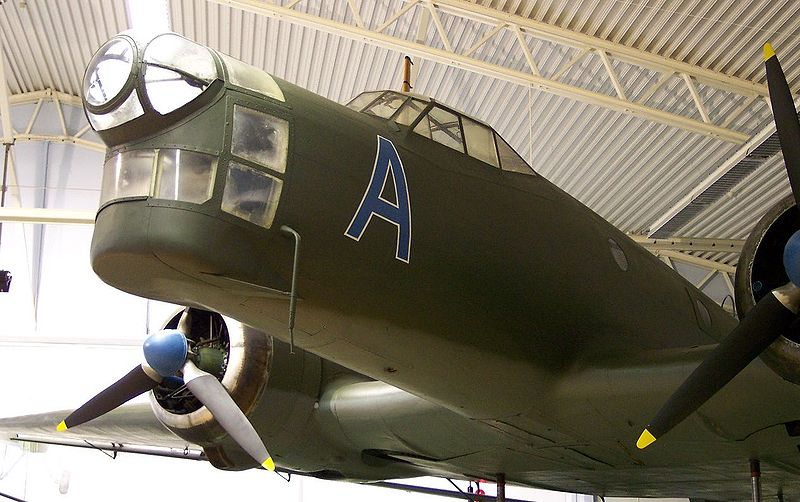 Swedish Ju 86 (the sole survivor as of 2021)
Swedish Ju 86 (the sole survivor as of 2021)
As for the dream I had and the movie I saw which kicked this off, I have no rational or scientific explanation for how that happened. I get it, coincidences happen. But wildly improbable juxtapositions of factoids beggar belief. Did my subconscious while I was dreaming direct my wife to find a movie that had RAF Northolt in it, something she couldn't possibly have known from browsing the movie choices on the free streaming channels? Or did a premonition from watching the movie six hours in the future reach into my subconscious mind and trigger a dream about something I read about over a year ago? Or do we have access to some kind of communal memory banks where all this information is stored, a sort of internet of human memory and experience?
I don't know, and I guess no one else alive knows. For now I'm filing this under the category "weird, weirder, weirdest".
This article was inspired by an article published in Aviation History magazine in January 2017, by Pete Lehmann. Other information was from Wikipedia, and the information on the Find A Grave memorial for Galatzine. Most of the information I have on Genders, Reynolds and Gold is from a website called The Tartan Terror Blogspot. I will attach detailed links and sources below once I've finished everything else up on the article.
Page first created 29 August 2021, first draft finished 26 September 2021
I found several photos online to add to the article. I was having difficulty with finding a Spitfire IX photo and then realized I had some Spitfire photos from the Museum of Flight in Seattle which I took two years ago. Combing through them it turned out the Spitfire was in fact a Mark IX. This one was not modified for high altitude combat, but I doubt any of those planes are still around today. The one at the museum was manufactured in March 1944 in Birmingham England and flew during D-Day, serving with 126 Squadron out of RAF Sawbridgeworth. It was used during the filming of the movie "The Longest Day" and owned by the actor Cliff Robertson from 1963 to 1996 or 1998, when he sold it to Craig McCaw. It was purchased by the Museum of Flight in 2000. I first saw the plane there in 2004, and was happy to see it was still there in 2019.
Sources:
Hugo Junkers at Wikipedia
The article on him is relatively brief. Considering his status in the history of aviation I may look for a better article and post a link here. The German Wikipedia article is a little longer, but not much
The Luftwaffe's High-Flying Diesel-Powered Bomber by Pete Lehmann, published January 2017 "Aviation History" magazine, currently viewable on HistoryNet.com
Sqn Ldr G.E.C Eric Genders AFC DFM 1920-1950 Published Wednesday, April 01, 2009 under the category "Test & Research Pilots, Flight Test Engineers" on The Tartan Terror Blogspot.com
Prince Emanuel Vladimirovich Galitzine Memorial 188973288 at FindAGrave.com
Ernst Zindel at German Wikipedia
Junkers Ju 86 at Wikipedia
(There is a German Wikipedia article available that is substantially longer than the English version, I am going to have to take a look at it when I get a chance)
I do take some of the information in the English language Wikipedia article with a grain of salt as it contradicts other sources that seem to be more authoritative. It is possible the German language version is more accurate. Nothing against Wikipedia but there is misinformation on the site, particularly about current affairs, recent history, and politically tinged topics. In this case I don't think there's any malicious intent on the possible wrong information, it's just that someone got some facts wrong.
History of Spitfire MK IX MK923 (Cliff Robertson's plane)
Chapter 11
Whistling Through the Graveyard, Chapter 11 - The Section of Lost Children
Whistling Past The Runway, Chapter 2 - Air Force Versus Navy, This Was Not A Game, But Both Sides Lost
Other navigation links on my site
Return to Whistling Through The Graveyard Page
Return to Genealogy Links
Return to Main Page
Contact us
© 2021-2025 by Christopher Mills








